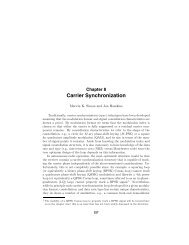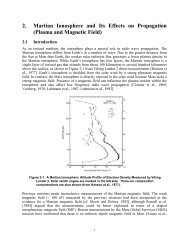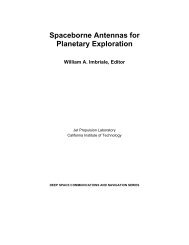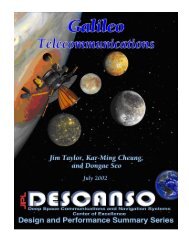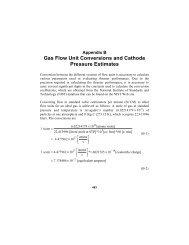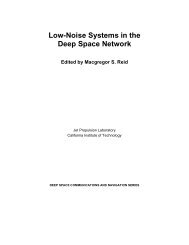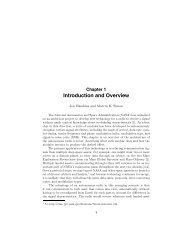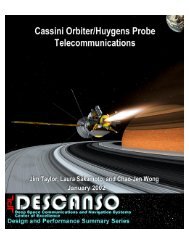Propagation Effects Handbook for Satellite Systems - DESCANSO ...
Propagation Effects Handbook for Satellite Systems - DESCANSO ...
Propagation Effects Handbook for Satellite Systems - DESCANSO ...
Create successful ePaper yourself
Turn your PDF publications into a flip-book with our unique Google optimized e-Paper software.
Ghobrial, et al (1978) have calculated a theoretical specific<br />
attenuation <strong>for</strong> sand. Based on the characteristics of particles<br />
collected during sandstorms, they conclude that negligible<br />
attenuation is suffered by X-band transmissions through sandstorms.<br />
This is due to the small particle size compared to the wavelength<br />
and the low loss tangent <strong>for</strong> sand.<br />
Chu (1979) reported that attenuation coefficients from sand<br />
particles at microwave frequencies were linearly proportional to<br />
frequency, and inversely proportional to optical visibility. The<br />
attenuation coefficients <strong>for</strong> distributions of identical particles<br />
were linearly proportional to particle radius. Other theoretical<br />
analyses have shown that sand and dust particle attenuation at<br />
microwave frequencies tends to be significant at very high particle<br />
concentrations (risibilities of less than 20m), or at high moisture<br />
contents, or both [Bashir et al. (1980), Ansari and Evans (1982),<br />
Goldhirsh (1982)].<br />
Blowing sand and dust storms occur in some regions of the U.S.<br />
These are recorded by the Weather Service as part of the Local<br />
Climatological Data (LCD) at the 291 stations. Ground stations<br />
needing this in<strong>for</strong>mation should review the data recorded by a nearby<br />
LCD recording station.<br />
The vertical extent of these sand storms is unknown, but it<br />
seems unlikely that high concentrations would exceed 1 km. The path<br />
length is expected to vary between 1/2 and 3 km, generally resulting<br />
in a total additional attenuation due to sand of the order of 1 dB<br />
or less. No measured satellite beacon link data is available to<br />
confirm these results.<br />
6.5 PREDICTION OF SIGNAL FLUCTUATIONS AND LOW-ANGLE FADING ON<br />
EARTH-SPACE PATHS<br />
The amplitude, phase, and angle-of-arrival of a microwave signal<br />
passing through the troposphere vary due to inhomogeneities in the<br />
refractivity (clear air). The effects occur on ‘ ime scales shorter<br />
6-74





